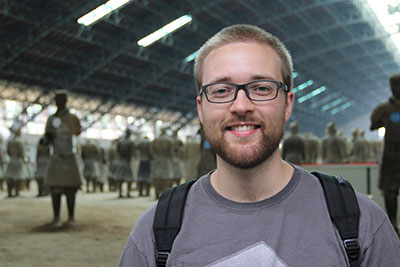
Hometown, Country:
Pikeville, KY, USA
Academic history prior to coming to MIT:
B.S. in Electrical Engineering at Univ. of Kentucky, M.S. in Electrical Engineering at Univ. of Kentucky
What brought you to MIT?
As an undergraduate at the University of Kentucky, I was fortunate to get an early start doing research on plasmonic biosensors. This project combined optics and fabrication to create devices that improve the detection of binding events on a surface. Designing such sensors stimulated my interest in optics and electromagnetics, and, while I didn’t have a specific project in mind, I was sure that I wanted to continue working in these fields as a PhD student. Upon arriving at MIT and meeting Professor Kärtner, I was introduced to a project seeking to improve both the production and measurement of some of the shortest pulses of light, being just tens of attoseconds in duration. To me, it was too interesting to resist.
What problem are you trying to solve with your current research and what are some possible applications?
Currently, I am still working on ways to improve the characterization of attosecond pulses of extreme ultraviolet (EUV) light. Such pulses have the potential to probe electron dynamics in solids and gases. While femtosecond pulses of light have been used to characterize molecular dynamics, the electronic motion within atoms and molecules occurs on attosecond timescales.
The idea is simple: the better we understand the pulses of EUV light we are generating, the better we can understand the subsequent electron dynamics that the pulses induce within the atom/molecule being studied.
Beyond improving the characterization of attosecond pulses of photons, another current topic of interest to me is the characterization of attosecond bursts of electrons emitted directly from nano-tips. In this project, we are studying how nanostructured arrays of tips (typically made of silicon or gold) emit electrons when triggered with relatively high peak electric fields from near-infrared pulses of light. We have already concluded that we can drive the emission process into a tunneling regime, implying that attosecond bursts of electrons are being emitted across a large array of tips. This could lead to improvements in time resolved electron microscopy, and has applications in novel table-top x‑ray light sources.
What interests you most about your research?
I have found that the most attractive part of my research is that it straddles the border between fundamental science and engineering. For instance, the design of the nano-tips includes electromagnetic modeling and fabrication that are more well understood and pushes engineering boundaries. However, the optically
induced electron emission mechanism is still in the process of being understood on a fundamental level. So, as we learn more about this emission process through experimental investigation, we can use these results to make design changes that take advantage of what we have learned.
What are your future plans?
In the future, I would like to be able to start my own group and continue the investigations I have started here and branch out into others along the way. I
have found that I keep coming back to projects that include all aspects of modeling, design and testing, and would like to continue in this fashion to develop novel devices that do useful things with light.
